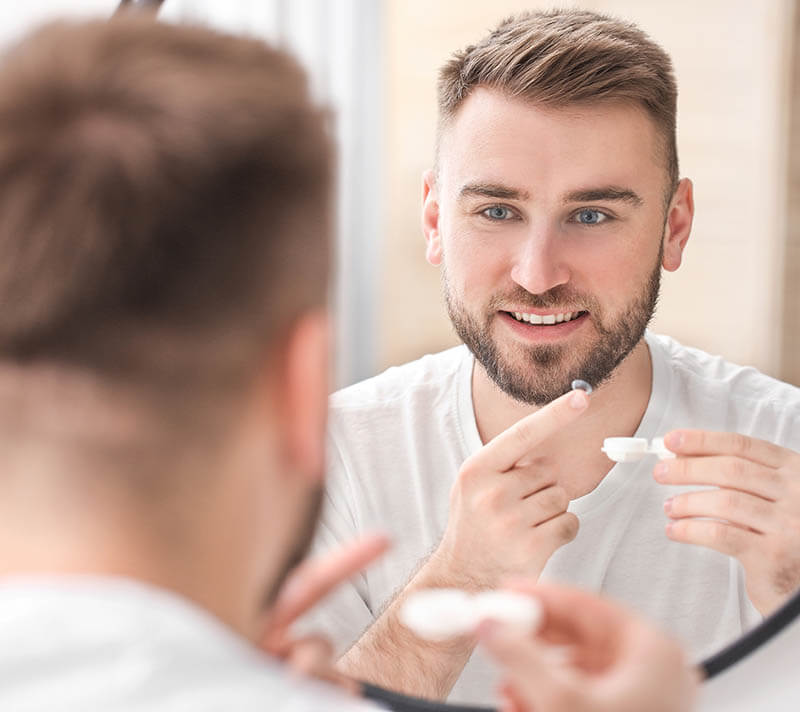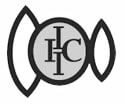Specialty Contact Lenses
There are many types of contact lenses and many reasons to wear them. At Slade and Baker Vision Center, we offer a variety of contact lens options:
Disposable Soft Contact Lenses
Disposable soft contact lenses are a great choice for many people. They are comfortable and are low maintenance as they are discarded every month, two weeks or even daily. Soft lenses are available to correct nearsightedness, farsightedness, astigmatism and presbyopia.
Gas Permeable Lenses
Gas permeable lenses are another great option for patients. After a lens adaptation period, the lenses are very easy to insert and remove and vision is usually quite sharp. These lenses are a healthy choice as they are very oxygen permeable. They can also be highly customized for patients who have high astigmatism, keratoconus, or for those who have had a corneal transplant or refractive surgery.

SynergEyes® Hybrid Contact Lenses
SynergEyes® hybrid contact lenses are also available at Slade and Baker Vision Center. They have a unique design of a gas permeable center with a soft lens skirt, providing the sharp vision and breathable material of a gas permeable lens and the comfort of a soft lens. These lenses now come in a wide range of parameters to maximize both fit and vision and are customized and manufactured individually for each patient.
Contact lenses are fit for many reasons including correcting nearsightedness, farsightedness, astigmatism, and presbyopia. They are also used for therapeutic purposes such as after refractive surgery or for keratoconus. Athletes, young patients who are not yet ready for refractive surgery, and patients who need bifocals but do not wish to wear glasses can also benefit from wearing contact lenses.
Dr. Baker has over 25 years of fitting regular and specialty contact lenses. He even helped develop a reverse-geometry lens designed especially for post-radial keratotomy patients. Dr. Essa has been residency trained in fitting contact lenses, including fitting specialty lenses for the hard-to-fit patient. If you would like to be fit for contact lenses by Dr. Baker or Dr. Essa, please make an appointment by calling us at 713-626-5544.
Contact Lens Fitting Process
Our contact lens fitting exam and assessment include: measuring corneal topography, corneal curvature, pupil size, and intraocular pressure; performing refraction, dilation, and retinal exam; evaluating tears, blink pattern, and lid anatomy; discussing expectations, and evaluating any previous lenses. After, contact lenses will be put on the eye and evaluated for proper fitting characteristics such as good movement, centration, lens coverage, and any rotation of the lenses.
If your test results are approved and we determine you are a good candidate, most types of lenses can be dispensed to you the same day from our inventory. If a customized lens is necessary, it will need to be ordered and it will be dispensed to you in our office upon delivery. We will provide you with instructions on handling, cleaning, inserting, and removing your contacts at the time of dispensing.
Patients are usually asked to return to the office a week or two after dispensing the contacts for evaluation of compatibility, wearing schedule, fit, quality of vision, and performance within the eye. Adjustments to the contact lenses are made when indicated at no additional cost during the fitting period.
Keys to Wearing Contact Lenses
There are a number of keys to wearing contact lenses successfully:
#1 Motivation
Ask yourself why you want to wear contact lenses. Is it to look better, to see better, or to reduce your dependence upon glasses? Whatever the reason, contact lens patients have to be motivated and have realistic expectations. Finding the ideal contact lens for you may take several tries and adjustments. Lenses selected and worn in the office for 30 minutes may feel different after several full days of wear.
The actual shape of your cornea can change after wearing them for a while. Blink patterns and tear film can change as patients adapt to wearing contacts. If you understand there is always a bit of trial and error to obtain the best fit, chances are you will be a successful contact lens wearer.
#2 Refractive Error
The type of refractive error you have can influence your chances of success. Some refractive errors can be corrected with standard lenses. More complex prescriptions may require more complex or specialty contact lenses.
Your initial exam will determine if your refractive error is simple or complex and where it is located (cornea or lens inside the eye). Corneal dystrophies, corneal transplant, and post-refractive surgery patients are always more complex but we can usually obtain success with one of the many new technology contact lenses available at our offices.
#3 Compliance
The way patients comply with recommended handling, cleaning, storage, replacement, and the prescribed wearing schedule has a significant influence on success. Lenses must be clean to perform their best and eyes are more tolerant of a consistent wearing schedule.
#4 Hygiene & Environment
Hygiene and the environment also have an influence on success. Lid hygiene can affect the chemistry and production of tears necessary for hydration and comfort. Lid conditions such as blepharitis, meibomitis, or other lid abnormalities, can affect the secretion of the oil glands that keep our tears from evaporating too quickly.
Contact lenses become soiled more quickly if the eyes are dry. Patients who have dry eye can be treated prior to contact lens fitting to improve their chances for success.
As we age, our eyes have a tendency to become drier, and many previously successful contact lens wear may lose their compatibility with contact lenses. Many of our patients regain their success with contacts by improving their “dry eye” symptoms with therapy.
Many contact lens failures, however, are able to experience success with refractive or intraocular lens replacement surgery. We can evaluate and recommend the best option if your contacts can no longer be tolerated.
#5 Fit
The physical fit of the contact lens and its alignment and movement when blinking is important in providing tear exchange under the contact. This provides oxygen to the cornea for normal metabolism and eliminates debris and by-products.
There are many different manufacturers of contact lenses with many different designs, materials, and fitting characteristics. At Slade & Baker Vision, we have state-of-the-art equipment in order to measure the dimensions of your cornea and allow us to select the very best fit for you.
***Latest Contact Lens Updates***
The most recent contact lens addition to Slade and Baker Vision Center has been the SynergEyes® Duette lens. It is a hybrid lens that was created especially for patients with astigmatism. Good candidates for this lens are patients with astigmatism, soft toric lens wearers looking for more consistent vision, gas permeable lens wearers seeking improved comfort, patients with an active lifestyle, athletes, and those who require sharp, consistent vision. If you are interested in being fit in this type of lens, please call our office and schedule your appointment today. We are currently offering a special introductory price on the Duette lenses. To read more about Duette lenses, please click here.
If you have questions, please do not ever hesitate to call our office at 713-626-5544 and speak to our experts and schedule a consultation today!

The doctors at Slade and Baker Vision have either authored or reviewed and approved this content.





